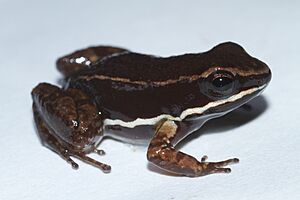Allobates talamancae facts for kids
Quick facts for kids Allobates talamancae |
|
|---|---|
 |
|
| Conservation status | |
| Scientific classification | |
| Synonyms | |
|
Dendrobates talamancae Cope, 1875 "1876" |
The Allobates talamancae is a small and interesting frog. You might also hear it called the Talamanca rocket frog or striped rocket frog. This little frog lives in Central and South America. You can find it in countries like Ecuador, Colombia, Panama, Costa Rica, and Nicaragua. It belongs to a group of frogs called Aromobatidae.
Contents
Meet the Talamanca Rocket Frog
The Talamanca rocket frog is quite small. Male frogs are usually about 17–24 mm (0.67–0.94 in) long from their nose to their bottom. Female frogs are a similar size, around 16–25 mm (0.63–0.98 in) long. That's about the size of a large paperclip!
This frog is not poisonous, so it's safe to be around. Its back is smooth and a dark brown color. The sides of its body are black. These black sides have a cool stripe above them that can be tan or bronze. Below the black, there's a white line. The frog's belly is also white. Its fingers and toes are not webbed, which means they don't have skin between them like a duck's foot.
How Talamanca Rocket Frogs Have Babies
These frogs have a special way of raising their young. The female frog lays her eggs on the ground, usually hidden in the leaf-litter. This is the layer of fallen leaves and twigs on the forest floor.
After the eggs hatch, both the mother and father frog help out. They carry the tiny baby frogs, called tadpoles, on their backs. They take them to small puddles or little pools of water in streams. The tadpoles then finish growing into frogs in these safe, watery spots.
Where They Live and How They Survive
The Talamanca rocket frog lives in very wet places. These include lowland areas and hillsides up to about 800 m (2,600 ft) high. In Colombia, they can even be found higher, up to 970 m (3,180 ft).
They like areas with lots of plants, like:
- Forests that are growing back after being cut down.
- Plantation areas, like farms where trees are grown.
- Swampy parts of old, untouched forests.
You will almost always find them near streams. They don't like open, sunny areas.
What They Eat
These frogs are carnivores, which means they eat meat. Their diet mainly consists of small insects and other tiny creatures with exoskeletons, called arthropods.
Staying Safe from Predators
Adult Talamanca rocket frogs often gather together in small groups. This is a clever way to protect themselves. By staying in a group, they make it harder for predators to catch them. It's like a "safety in numbers" strategy!
Protecting These Frogs
Even though the Talamanca rocket frog is common, it faces some challenges. Its home is slowly disappearing because of:
- Habitat loss: This happens when forests are cut down for farms or buildings.
- New fish: Sometimes, fish that don't naturally live in these areas are introduced. These new fish can eat the frog's tadpoles.
- Pollution: Water pollution from human activities can also harm the frogs and their environment.
Scientists and conservationists are working to protect these amazing frogs and their homes.


